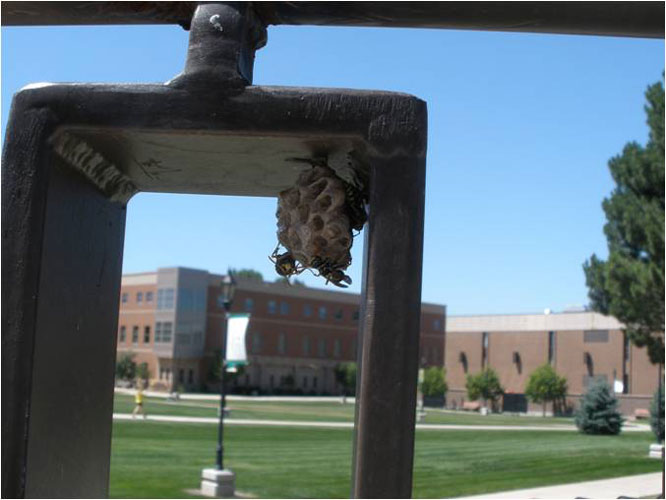Dr. Downing researches new species of wasp
Dr. Holly Downing is ex dean of the College of Arts and Sciences and an active faculty member. She finished her undergraduate degree at Smith College in Massachusetts and received her Ph.D. in entomology from the University Of Wisconsin-Madison.
Dr. Downing has conducted much research that focuses on insect behavior. A few of them have revolved around wasps. Downing did her Ph.D. research on the native species polistes fuscatus, also known as common paper wasps, which are the common wasp species people in Spearfish are used to seeing around. As Dr. Downing explains, there are native and non-native species of wasps. The polistes fuscatus is a native type of wasp. This species spread from Michigan throughout the East coast of the USA.
“Although the polistes fuscatus does not produce honey, they are crucial to balance the ecosystem,” Downing said. “These wasps are predators, feeding themselves with insects such as worms, caterpillars and other types of bugs.”
Two years ago, mysterious and larger wasp nests started to appear around the Spearfish area. Since these nests were not typical of the native polistes fuscatus species, Downing went through other scientist’s articles and discovered that these new nests belonged to a new species of wasp known as the polistes dominula.
The polistes dominula is a wasp species that are usually found in some regions of Europe and Asia. They are smaller wasps that are more active and versatile when it comes to their preys and nests. Before 1980, polistes dominula was not recorded in North America. In 1981, this species started appearing around Boston and the wasps became known for their ability to tolerate humans and human activity. Polistes dominula reproduce quickly too.
Once the female has mated, they store male sperm all winter long in a sack in their abdomen and feed it to keep it alive. A female will start a nest when she is ready to lay eggs and if she decides to add sperm to an egg, she will get a female wasp, and if she doesn’t, she will get a male wasp. Females become the workers for the queen, building nests and taking care of the young.
Another proper characteristic of this species is that this type of wasps only build their nest in horizontal surfaces, so it became easy for them to start building their nests on more exposed places like house doors and windows.
“Natives wasps would never nest in those places, so it was new to see this happening,” said Downing.
After seeing them around campus, Downing decided to follow them and see how the wasp population dynamic changed with the appearance of this new species.
“I went out, looked around and documented that the wasps were actually in this area because there was no documentation of this species of wasp being here until 2 years ago,” Downing said.
As Downing found out, the nests of the polistes dominula were present in many areas of the campus.
“They nest in horizontal surfaces, which makes it easy to nest on campus surfaces like the corner windows in Meier Hall,” Downing said.
Also, their colonies are bigger than the native’s, which represents a threat for people that are allergic to stings.
“Polistes dominula has pretty much taken over Spearfish,” Downing said.
Through her research, Downing wants to find how the new species of wasp, polistes dominula, will influence the old native species, polistes fuscatus. The study also focuses on following the wasp population and looking for any dynamic changes that might be produced from the wasp’s interaction with other wasp species.
“I looked at the effect of these wasps on the population of polistes fuscatus and another wasp that occurs in this area that has a similar lifestyle,” said Downing.
Downing plans to keep her research going and keep observing the wasps. As she said, “I will keep looking to see the ongoing impact they have and see how this new species influence the polistes fuscatus.”


